Family
 When I think of geysers, Old Faithful Geyser in Yellowstone National Park immediately comes to my mind. Of course, there are many other geysers in Yellowstone National Park, and there are also geysers in other parts of the world. Most geysers occur naturally, but there is such a thing as a man-made geyser too. I never really knew that before. I guess I wonder, why anyone would “make” a geyser. Somehow, I have a feeling that it wasn’t exactly an intentional project.
When I think of geysers, Old Faithful Geyser in Yellowstone National Park immediately comes to my mind. Of course, there are many other geysers in Yellowstone National Park, and there are also geysers in other parts of the world. Most geysers occur naturally, but there is such a thing as a man-made geyser too. I never really knew that before. I guess I wonder, why anyone would “make” a geyser. Somehow, I have a feeling that it wasn’t exactly an intentional project.
One such man-made geyser is the Fly Geyser, which can be found on the edge of the Black Rock Desert. As tourist attractions go, this is one of the coolest. It was created 100 years ago in Nevada, but how was it created exactly? The geyser itself is very unusual, but minerals can create strange looking things. Before Fly Geyser became the colorful geyser we see today, it was simply a well, man-made in the 1900s. The well was dug in an effort to get irrigation water for the area. Then heated water shot out through the cracks. When geothermal water at close to the boiling point was found, the well was abandoned. Of course, the water was similar to that of the waters in Yellowstone, but not quite as hot. The minerals began to deposit on the surface of the ground, forming the 10 to 12 foot mound and the various terraces. Thermophilic algae gives the mound its beautiful red and greens streaks, which is the prettiest part of the geyser.
Fly Geyser is also known as Fly Ranch Geyser because it is located on the Fly Ranch on Nevada State Route 34, due east of Black Rock Desert and about 20 miles north of Gerlach, Nevada. Fly Geyser is located near the edge of Fly Reservoir in the Hualapai Flat Geothermal Flats and is approximately 5 feet high by 12 feet wide, counting the mound on which it sits. The source of the Fly Geyser field’s heat is attributed to a very deep pool  of hot rock where tectonic rifting and faulting are common. In 1964 a geothermic energy company drilled a second well near the site of the first well. The water was not hot enough for energy purposes. They reportedly capped the well, but the seal failed. The discharge from the second well released sufficient pressure that the original geyser dried up.
of hot rock where tectonic rifting and faulting are common. In 1964 a geothermic energy company drilled a second well near the site of the first well. The water was not hot enough for energy purposes. They reportedly capped the well, but the seal failed. The discharge from the second well released sufficient pressure that the original geyser dried up.
These days the Fly Geyser is a tourist attraction, Fly Ranch is open to small, guided three-hour nature walks from April to October of each year. The geyser is part of the nature walk. I love hiking, and I can only imagine how awesome it would be to hike out to a geyser…especially one as beautiful as the Fly Geyser.


 They never would have known, way back there in elementary school, but my grandson, Josh Petersen and his girlfriend, Athena Ramirez were going to be life-long friends, and now much more. Athena is a name of Greek origin meaning “Wise.” I like that. Years later, they found themselves working together, and they renewed their friendship, and before long that friendship grew into love. I can totally see why Josh is taken with Athena. She has a wonderful, bubbly personality, and a beautiful smile. She is such a happy person, so that smile shows up all the time.
They never would have known, way back there in elementary school, but my grandson, Josh Petersen and his girlfriend, Athena Ramirez were going to be life-long friends, and now much more. Athena is a name of Greek origin meaning “Wise.” I like that. Years later, they found themselves working together, and they renewed their friendship, and before long that friendship grew into love. I can totally see why Josh is taken with Athena. She has a wonderful, bubbly personality, and a beautiful smile. She is such a happy person, so that smile shows up all the time.
In perfect Athena-style, her favorite flower is the sunflower. She also likes roses, and the two of them together, 
 while not something you would expect to see, are beautiful. The sunflower totally fits Athena’s sunny disposition, so it makes the perfect favorite flower. Athena loves plants in general, so I know their apartment will be filled with beautiful plants. They even went to “Rock the Block” in downtown Casper earlier this month and got to paint so really cute planters. That made Athena very happy, because now she has more planters for the plants she wants in the apartment.
while not something you would expect to see, are beautiful. The sunflower totally fits Athena’s sunny disposition, so it makes the perfect favorite flower. Athena loves plants in general, so I know their apartment will be filled with beautiful plants. They even went to “Rock the Block” in downtown Casper earlier this month and got to paint so really cute planters. That made Athena very happy, because now she has more planters for the plants she wants in the apartment.
Athena not only loves plants, but she likes to get out in nature and see lots of them. One of her favorite activities is hiking, which my husband, Bob Schulenberg and I love to do as well. She loves spending time at the lake with her family and friends, and swimming and soaking up the sun. Being outdoors makes her feel happy and she spreads that happiness to those around her. Plus, it’s healthy to be out in the fresh air, hiking and enjoying nature. God made a beautiful world for us. Athena really loves to be out in it.
Athena is all about family. She loves her nieces and nephews, and loves spending time with her family. She has also enjoys hanging out with our family, because for her family is number one, and we have become her family too. No matter which family she is with, Athena brings the sunshine with her. I know my mom, Collene Spencer 
 would love that too, because her favorite saying was “Keep of the Sunny Side.” One day Athena can meet her and my dad, Allen Spencer in Heaven, and they will just love her. I think Josh really needed a sunny person in his life. He can be a little too serious sometimes. He forgets to have fun, and Athena has taught him to have fun again. I love the saying they have about each other. Josh is her always, and she is his forever. Just beautiful!! Today is Athena’s birthday. Happy birthday Athena!! Have a great day!! We love you!!
would love that too, because her favorite saying was “Keep of the Sunny Side.” One day Athena can meet her and my dad, Allen Spencer in Heaven, and they will just love her. I think Josh really needed a sunny person in his life. He can be a little too serious sometimes. He forgets to have fun, and Athena has taught him to have fun again. I love the saying they have about each other. Josh is her always, and she is his forever. Just beautiful!! Today is Athena’s birthday. Happy birthday Athena!! Have a great day!! We love you!!
 Krzywy Domek in Polish for “crooked house” and while the description is correct, it maybe should mean “a house to feel drunk in.” Krzywy Domek an unusually shaped building in Sopot, Poland, and when I say unusually shaped, I’m not kidding. This building looks like it melted or something. It could almost look like a house in a drug-induced stupor, but in reality it is considered a really fun place to go. It looks like a picture taken from a child’s fictional book. It is about 43,000 square feet in size and is part of the Rezydent shopping center. The building was designed by Szotynscy and Zaleski, who were inspired by the fairytale illustrations and drawings of Jan Marcin Szancer and Per Dahlberg. Krzywy Domek can be entered from either Monte Cassino or Morska Streets. Krzywy Domek was built in 2004. Since it was built, Krzywy Domek has had visitors all over the world. They have all come to have a look at this architectural wonder designed by the Polish architects. Szotynscy and Zaleski were said to be charmed by fairy tales’ illustrations.
Krzywy Domek in Polish for “crooked house” and while the description is correct, it maybe should mean “a house to feel drunk in.” Krzywy Domek an unusually shaped building in Sopot, Poland, and when I say unusually shaped, I’m not kidding. This building looks like it melted or something. It could almost look like a house in a drug-induced stupor, but in reality it is considered a really fun place to go. It looks like a picture taken from a child’s fictional book. It is about 43,000 square feet in size and is part of the Rezydent shopping center. The building was designed by Szotynscy and Zaleski, who were inspired by the fairytale illustrations and drawings of Jan Marcin Szancer and Per Dahlberg. Krzywy Domek can be entered from either Monte Cassino or Morska Streets. Krzywy Domek was built in 2004. Since it was built, Krzywy Domek has had visitors all over the world. They have all come to have a look at this architectural wonder designed by the Polish architects. Szotynscy and Zaleski were said to be charmed by fairy tales’ illustrations.

The strange design has many experts puzzled as to why, even given the architects interest in fairy tales. With its surreal details, this strange edifice is a puzzle to experts. It is said that this 43,000 square foot creation can be put up only by an artist, but maybe there is another reason for this strange creation. The Village of Joy portal published the list of the 50 strangest buildings of the world. The Krzywy Domek was awarded first place due to its unique, unusual, full of magic architecture inspired by the drawings of Jan Szancer. The Krzywy Domek defeated such world-wide buildings as the Torre Galatea Figueres in Spain, the public library in Kansas City in the USA, and the famous Guggenheim museum in Bilbao.
The building really is crooked, as its name suggests. It is full of strange and magical details: blue-enameled shingles on the roofs, colorful stained glass doors and windows, and stone elevation decors which seem an illusion to the eyes. It is also worth looking at night with its even more exclusive and captivating form. While  some people call it the “mind-melting” crooked house, others suggest that it looks like it went through warping software. It has also been known to almost induce vertigo. The strange building is home to a radio station, shopping centers, and centers for relaxation purposes. Strangely, the interior is really not crooked-looking, except for the stairs which are a bit slanted. The Crooked House or Krzywy Domek is also home to the “Wall of Fame” on which participants of Poland’s cultural events add their name…an idea that thrills its visitors. It’s a bit of a spin off of the Hollywood Walk of Fame. Personally, I think their “Wall of Fame” might be more interesting, although, it could be because of the Crooked House itself.
some people call it the “mind-melting” crooked house, others suggest that it looks like it went through warping software. It has also been known to almost induce vertigo. The strange building is home to a radio station, shopping centers, and centers for relaxation purposes. Strangely, the interior is really not crooked-looking, except for the stairs which are a bit slanted. The Crooked House or Krzywy Domek is also home to the “Wall of Fame” on which participants of Poland’s cultural events add their name…an idea that thrills its visitors. It’s a bit of a spin off of the Hollywood Walk of Fame. Personally, I think their “Wall of Fame” might be more interesting, although, it could be because of the Crooked House itself.

 She is smart and funny and curious and asks a million questions…and remembers the answers to all of them!! She is Jolene Thompson, the daughter of my niece Kellie Hadlock’s partner, Tim Thompson, and we all love her very much. Jolene has a smile that lights up your day. Her eyes light up and her whole face smiles. Jolene has had lots of exciting things going on this year. She and her daddy have gone hunting and fishing. Jolene loves to do anything her daddy likes to do. She loves shooting, and is learning to be a great shot.
She is smart and funny and curious and asks a million questions…and remembers the answers to all of them!! She is Jolene Thompson, the daughter of my niece Kellie Hadlock’s partner, Tim Thompson, and we all love her very much. Jolene has a smile that lights up your day. Her eyes light up and her whole face smiles. Jolene has had lots of exciting things going on this year. She and her daddy have gone hunting and fishing. Jolene loves to do anything her daddy likes to do. She loves shooting, and is learning to be a great shot.
Jolene is a pretty little girl, who is tough as nails. There isn’t a wimpy bone in her body, and she proves that with every camping trip she takes with Tim and Kellie, or with just Tim. She doesn’t shirk her share of the work. I realize that a little girl can’t do a lot of heavy lifting in a camping situation, but Jolene carries her weight, and makes her daddy and 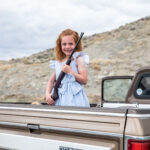
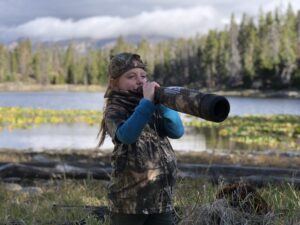 Kellie very proud. Jolene is friendly, and easy to get along with. She and Kellie have become best friends. They love each other so much. Jolene is so brave and KIND! Kellie cannot say enough about how kind she is. This world needs kind people like Jolene.
Kellie very proud. Jolene is friendly, and easy to get along with. She and Kellie have become best friends. They love each other so much. Jolene is so brave and KIND! Kellie cannot say enough about how kind she is. This world needs kind people like Jolene.
This summer, Jolene got to go to Vacation Bible School with her Aunt Sarah Jarvis. She also loves spending time with Nana and Pop Pop (Tim’s parents, Lynn and Tim Thompson) and with her baby cousin Jasper. Jolene has just started Kindergarten, and is having a great time. Her curious mind is busily absorbing all the new information she is being taught in school. She loves to draw and build things. She loves animals. Both Tim and Kellie have dogs, so Jolene has “fur babies” to love.
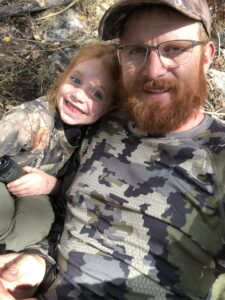
 Jolene has decided that she wants to be a police officer when she grows up. That seems to be the norm in the Hadlock sphere of influence. It is a good thing to get into, and a tough as nails girl like Jolene should do very well in such a career. She is already working on her shooting skills, so she is ahead of the game. And speaking of game, Jolene went elk hunting with her dad this year, and had a great time. As a non-hunter, I can say that I don’t know much about it, but Jolene is learning quite a bit about ways to draw the bull elk near for the kill. She has learned to facilitate bugling and even even cow elk urine to draw the male in. Now, I can’t say that I would be interested in that, but if I were a hunter, I’m sure I would. Go Jolene!! Today is Jolene’s 6th birthday. Happy birthday Jolene!! Have a great day!! We love you!!
Jolene has decided that she wants to be a police officer when she grows up. That seems to be the norm in the Hadlock sphere of influence. It is a good thing to get into, and a tough as nails girl like Jolene should do very well in such a career. She is already working on her shooting skills, so she is ahead of the game. And speaking of game, Jolene went elk hunting with her dad this year, and had a great time. As a non-hunter, I can say that I don’t know much about it, but Jolene is learning quite a bit about ways to draw the bull elk near for the kill. She has learned to facilitate bugling and even even cow elk urine to draw the male in. Now, I can’t say that I would be interested in that, but if I were a hunter, I’m sure I would. Go Jolene!! Today is Jolene’s 6th birthday. Happy birthday Jolene!! Have a great day!! We love you!!
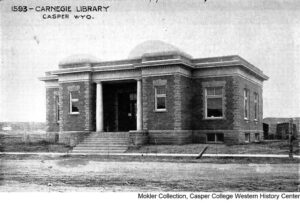 Andrew Carnegie is a name most people have heard of, at least when you think of places like Carnegie Hall, but that isn’t something that has much in common with places like Wyoming…or does it? Andrew Carnegie was born to Margaret Morrison Carnegie and William Carnegie in Dunfermline, Scotland. The family lived in a typical weaver’s cottage with only one main room, consisting of half the ground floor, which was shared with the neighboring weaver’s family. It was here in very humble beginnings that Andrew Carnegie made his debut. When Carnegie was 12, his father had fallen on very hard times as a handloom weaver. To add to the family’s predicament, the country was in starvation. His mother helped support the family by assisting her brother and by selling potted meats at her “sweetie shop,” making her the primary income in the family. The family was struggling to make ends meet and they knew they weren’t going to make it…at least not in Scotland. The Carnegies then decided to borrow money from George Lauder, Sr and move to Allegheny, Pennsylvania, in the United States in 1848 for the prospect of a better life. In September 1848, Carnegie arrived with his family in Allegheny. That was not the end of their struggles, however. Carnegie’s father struggled to sell his product on his own, but eventually father and son both received job offers at the same Scottish-owned cotton mill, Anchor Cotton Mills. At least they had some income, meager as it was.
Andrew Carnegie is a name most people have heard of, at least when you think of places like Carnegie Hall, but that isn’t something that has much in common with places like Wyoming…or does it? Andrew Carnegie was born to Margaret Morrison Carnegie and William Carnegie in Dunfermline, Scotland. The family lived in a typical weaver’s cottage with only one main room, consisting of half the ground floor, which was shared with the neighboring weaver’s family. It was here in very humble beginnings that Andrew Carnegie made his debut. When Carnegie was 12, his father had fallen on very hard times as a handloom weaver. To add to the family’s predicament, the country was in starvation. His mother helped support the family by assisting her brother and by selling potted meats at her “sweetie shop,” making her the primary income in the family. The family was struggling to make ends meet and they knew they weren’t going to make it…at least not in Scotland. The Carnegies then decided to borrow money from George Lauder, Sr and move to Allegheny, Pennsylvania, in the United States in 1848 for the prospect of a better life. In September 1848, Carnegie arrived with his family in Allegheny. That was not the end of their struggles, however. Carnegie’s father struggled to sell his product on his own, but eventually father and son both received job offers at the same Scottish-owned cotton mill, Anchor Cotton Mills. At least they had some income, meager as it was.
Young Andrew Carnegie was destined for better things, however. In his adult life, Andrew Carnegie enjoyed success in businesses ranging from oil to railroads to steel, Carnegie became one of the wealthiest Americans of his era. After selling off his businesses and retiring in the early part of the 20th-century, Carnegie spent the remainder of his life giving away much of his enormous wealth. It was this portion of Carnegie’s life that would forever tie him to Casper, Wyoming, and to many other towns across the country. Casper’s connection to one of America’s most generous philanthropists can be found right on the corner of Durbin and Second Street downtown…the Natrona County Public Library.
In an incredible display of generosity, Andrew Carnegie’s library foundation helped build over 1,700 public libraries around the country. As word got out, in 1905, Casper mayor Wilson Kimball wrote to the Carnegie Foundation hoping to secure a grant to start a library in his dusty, rapidly growing town. His letter read, in part, “We have a town here of at the present time about 1,500 population and there is probably not a more cosmopolitan town, of its size, in the United States. A Carnegie Library here would benefit a class that are seldom benefited by such institutions, and would afford a quiet, wholesome and instructive resort of character that are too scarce in these western range towns.” The Carnegie Foundation agreed to gift Casper, Wyoming a $10,000 grant. Land for the library was donated to the cause. The small, yet elegant design for the building ended up coming in over budget. The Carnegie Foundation was a bit frustrated, but with a few concessions from Casper, the foundation agreed to another $3,000 to help finish the project. By 1910 at the edge of town, Casper’s library was completed. The building with its classical design, high quality masonry and three domes stood out in the town. Casper was basically still a prairie, with muddy streets and stick buildings in 1910.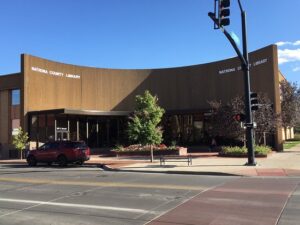
Before long, the library was obviously to small, and in the early 1920s a new design was seamlessly integrated into the original building, adding much needed space for events and collections. After the World Wars, Casper began to grow rapidly, and a prosperous Casper, added a modern addition which opened in 1952. By the late 1960s, the original sections of the Carnegie building had become obsolete and fallen into disrepair. A good portion of the old building had been relegated to storage. Sadly, in 1970, the original building was demolished and the final addition we have today was built. It was the end of the visible Carnegie connection to Casper. In all, Wyoming built a total of 16 Carnegie libraries. Ten remain.

 Recently, I ran across an article about drug use in among the Nazi regime. The article really caught my attention, because in many ways drug use among the Nazis made sense. The things they did to people would have been much easier if they were under the influence of drugs…mostly because they would be less likely to remember what they had done, and if they remembered, they would be less likely to care about what they had done. Drugs tend to dull the senses, and in many cases that makes the person relaxed and calm, but there are some drugs that make the person violent too. The article started out saying, “‘You can learn a lot about a culture from its drug use.’ Robert McAlmon, an American author living in Berlin during the tumultuous Weimar years, marveled that ‘dope, mostly cocaine, was to be had in profusion’ at ‘dreary night clubs’ where ‘poverty-stricken boys and girls of good German families sold it, and took it.’”
Recently, I ran across an article about drug use in among the Nazi regime. The article really caught my attention, because in many ways drug use among the Nazis made sense. The things they did to people would have been much easier if they were under the influence of drugs…mostly because they would be less likely to remember what they had done, and if they remembered, they would be less likely to care about what they had done. Drugs tend to dull the senses, and in many cases that makes the person relaxed and calm, but there are some drugs that make the person violent too. The article started out saying, “‘You can learn a lot about a culture from its drug use.’ Robert McAlmon, an American author living in Berlin during the tumultuous Weimar years, marveled that ‘dope, mostly cocaine, was to be had in profusion’ at ‘dreary night clubs’ where ‘poverty-stricken boys and girls of good German families sold it, and took it.’”
Over the years, a number of drugs have been banned, due to the danger of their use, the reactions of those taking them, or just that they are now deemed illegal. Cocaine was banned in 1924, but that has not really stopped it’s use. Like most drugs, if there is a “market” for it, someone will find a way to get the drug to the “customer.” Meth has become so easy to make and uses common (but poisonous) ingredients, so it has become the drug of choice for many drug addicts today. Some prescription drugs are addictive, and have become a part of the drug trafficking world too. Drugs like Opioids and Morphine are fairly easy to obtain from a doctor, because they hare used for many injuries and common ailments. Then they become addicted, and when they can no longer get a prescription for those drugs, they move on to illegal drugs.
Strangely, when the Nazis rose to power, illegal drug consumption actually fell. The Nazis regarded drugs as “toxic” to the German body. Drug users were given prison sentences, and addicts were classed…along with Jews, gypsies and homosexuals…as undesirable social elements. By the end of the 1930s, the Nazi pharmaceutical companies had turned away from opioids and cocaine, and moved towards synthetic stimulants. These could be produced entirely within Germany, per Nazi directive, of course. More money in the pocket of Hitler’s regime. “The transition from cabaret cocaine to over-the-counter meth helped fuel what German journalist Norman Ohler in his new book Blitzed: Drugs in the Third Reich calls the ‘developing performance society’ of the early Nazi era, and primed Germany for the war to come.”
I’m sure that the Third Reich, while calling it “developing performance society,” knew that the the use of these drugs was going to make the people taking the drugs more compliant to the government. Once a person is addicted to a drug, many will do anything to get a “fix,” including theft, robbery, breaking and entering, selling themselves, and even begging to get more. In 1937, the German pharmaceutical company called Temmler-Werke introduced Pervitin, which was a methamphetamine-based stimulant. The formula was developed by Dr Fritz Hauschild. He went on to pioneer East Germany’s sports doping program. Within a few months, this variant of crystal meth was available without a prescription, and was even sold in boxed chocolates. It was also widely adopted by people from all walks of life to elevate mood, control weight gain, and increase productivity. Pervitin’s success as an over-the-counter “wonder drug” caused a rebound in the country’s economic status after the war. The country came out of an economic depression to nearly full employment. Marketing for Pervitin claimed it would help “integrate shirkers, malingerers, defeatists, and whiners” into the rapidly expanding workforce. Students took it to cram for exams, while housewives took it to stave off depression. Pervitin use was so common that it became a normal part of life in the early Third Reich. For the military personnel of Hitler’s army, the chemical was a great weapon to fight the so-called “war on exhaustion.” The troops started relying on the “tank chocolate” to keep them alert for days on end. Before long, Nazi medical 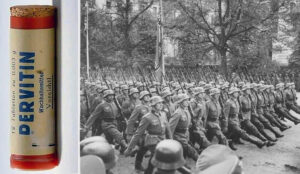 officials became increasingly aware of Pervitin’s risk factor. The tests performed on soldiers found that critical thinking skills declined the longer they stayed awake, even if the short-term gains were appealing enough. Even after drug sales to the general public were restricted in April 1940, the German Army High Command issued the so-called “stimulant decree,” ordering Temmler to produce 35 million tablets for military use. Of course, we know now that methamphetamine use is not only dangerous, but often deadly. The addictive effects alone can ruin lives. I don’t suppose Hitler cared much about that, as long as his troops obeyed his commands. I wonder how many men lost their lives because of the drug.
officials became increasingly aware of Pervitin’s risk factor. The tests performed on soldiers found that critical thinking skills declined the longer they stayed awake, even if the short-term gains were appealing enough. Even after drug sales to the general public were restricted in April 1940, the German Army High Command issued the so-called “stimulant decree,” ordering Temmler to produce 35 million tablets for military use. Of course, we know now that methamphetamine use is not only dangerous, but often deadly. The addictive effects alone can ruin lives. I don’t suppose Hitler cared much about that, as long as his troops obeyed his commands. I wonder how many men lost their lives because of the drug.

 After making a move from Casper, Wyoming to Cheyenne, Wyoming on June 5th, my nephew, Jason Sawdon is settling into his new job and promotion, and great hours for a family man, with the Wyoming Highway Patrol. Jason has had a long and successful career with the WHP, and this promotion to Sergeant of Equipment and Technology, is the next step in his decorated career. Jason’s job is to coordinate and test the equipment to make sure it is safe and effective for use in the WHP. He is so well respected and such a help to all who need him, which is no surprise considering his helpful nature. With the promotion comes a great schedule for a family man, with a wife who works from home. Jason now has evenings, weekends, and holidays off, so he and his girls…my niece, Jessi and their daughter, Adelaide, as well as, their dog, Daisy, have been busy exploring the Cheyenne area when they aren’t doing some DIY projects on their home.
After making a move from Casper, Wyoming to Cheyenne, Wyoming on June 5th, my nephew, Jason Sawdon is settling into his new job and promotion, and great hours for a family man, with the Wyoming Highway Patrol. Jason has had a long and successful career with the WHP, and this promotion to Sergeant of Equipment and Technology, is the next step in his decorated career. Jason’s job is to coordinate and test the equipment to make sure it is safe and effective for use in the WHP. He is so well respected and such a help to all who need him, which is no surprise considering his helpful nature. With the promotion comes a great schedule for a family man, with a wife who works from home. Jason now has evenings, weekends, and holidays off, so he and his girls…my niece, Jessi and their daughter, Adelaide, as well as, their dog, Daisy, have been busy exploring the Cheyenne area when they aren’t doing some DIY projects on their home.
Having weekends and holidays off has given the family lots of time for trips, so this summer, they have visited Laramie, Michigan, Denver, Casper, the Snowy Range, Medicine Bow National Forest, and Guernsey State Park. It has also been fun for them to explore their new area and Jason has had a blast doing it. The summer has 
 flown by, and they have been so busy that they didn’t get to go camping as much as they would have liked, but they are going camping this weekend, so that will be fun.
flown by, and they have been so busy that they didn’t get to go camping as much as they would have liked, but they are going camping this weekend, so that will be fun.
My niece, Kellie Hadlock, Jessi’s sister tells me that Jason is the most helpful person on the planet! He can fix anything. It’s always nice to have a handyman around the house. Jason is a good cook too, even if he made the hottest tacos on the planet…totally by accident, of course, the last time Kellie visited them. Hot is a relative concept, because there are those of us who believe that it isn’t hot enough, unless it makes your lips numb and your nose run…me included. I suppose there could be a level called “too hot,” but I really can’t say I have found that yet, but then I haven’t tried every pepper. Maybe someday.
Jason is a very hands on dad, often helping daughter, Addi build things and learn new things. Addi just adores her daddy. Recently, the Sawdon and Hadlock families got the chance to go to an air show at the Cheyenne 
 Regional Airport, and then they got to tour the vintage World War II planes there, as well as the more modern helicopters. They had a wonderful time going through them since my dad, Jessi’s grandpa, Al Spencer served as top turret gunner on a B-17, based in Great Ashfield, Suffolk, England during the war. Going through those planes is always a sentimental journey for our family. Now, the next generation will get to love it too. Today is Jason’s birthday. Happy birthday Jason!! Have a great day!! We love you!!
Regional Airport, and then they got to tour the vintage World War II planes there, as well as the more modern helicopters. They had a wonderful time going through them since my dad, Jessi’s grandpa, Al Spencer served as top turret gunner on a B-17, based in Great Ashfield, Suffolk, England during the war. Going through those planes is always a sentimental journey for our family. Now, the next generation will get to love it too. Today is Jason’s birthday. Happy birthday Jason!! Have a great day!! We love you!!
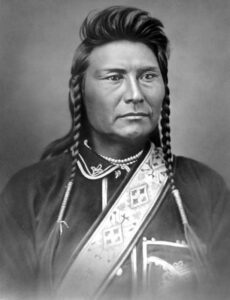 Nez Perce Chief Him-mah-too-yah-lat-kekt (“Thunder Rolling Down from the Mountains”), while chief of the Nez Perce Indian tribe, was not a warrior chief. Chief Joseph, as he was known to the “White Man” who could not easily pronounce his name, was much more diplomat than warrior, and he could see the writing on the wall. It wasn’t that he was a quitter or a traitor to his people, but rather that he could see that the government was going to take the fertile land his tribe occupied in northeastern Oregon, and they would kill them all, if necessary, to get what they wanted.
Nez Perce Chief Him-mah-too-yah-lat-kekt (“Thunder Rolling Down from the Mountains”), while chief of the Nez Perce Indian tribe, was not a warrior chief. Chief Joseph, as he was known to the “White Man” who could not easily pronounce his name, was much more diplomat than warrior, and he could see the writing on the wall. It wasn’t that he was a quitter or a traitor to his people, but rather that he could see that the government was going to take the fertile land his tribe occupied in northeastern Oregon, and they would kill them all, if necessary, to get what they wanted.
Chief Joseph was elected chief of the Wallowa band of Nez Perce Indians at the very young age of 31. The first six years were difficult as the young leader struggled peacefully against the whites who wanted the fertile land of Wallowa’s in northeastern Oregon. Things really heated up in 1877, when General Howard of the US Army warned the young chief that if the Wallowa and other bands of the Nez Perce did not abandon their land and move to the Lapwai Reservation within 30 days, his troops would attack. Chief Joe knew that the Indians would be severely outnumbered, and he hated the thought of all of his people being injured and killed, only to find out that the outcome was the same…the land would ultimately end up in the hands of the white settlers. While some of the other Nez Perce chiefs argued they should resist, Chief Joseph convinced them to comply with the order rather than face war, and he led his people on a perilous voyage across the flood-filled Snake and Salmon River canyons to a campsite near the Lapwai Reservation.
Unfortunately, acting without Chief Joseph’s knowledge, a angry band of 20 young braves decided to take 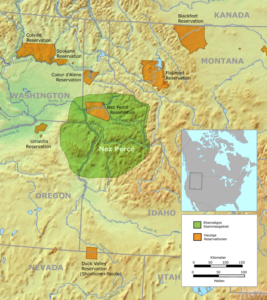 matters into their own hands. They exacted their “revenge” on some of the more offensive white occupiers in the region, sparking the Nez Perce War of 1877. The US Army’s pursuit of about 750 Nez Perce and a small allied band of the Palouse tribe, led by Chief Joseph and others, as they attempted to escape from Idaho became known as the Nez Perce War. The Indians had hoped to take refuge with the Crow Nation in the Montana Territory, but the Crow refused to harbor them, so the Nez Perce went north in an attempt to obtain asylum with the Lakota band led by Sitting Bull, who had fled to Canada following the Great Sioux War in 1876. The Nez Perce ware raged from June through October of that year, with Chief Joseph being the only major leader to survive. Joseph’s younger brother, Olikut, was the major force in leading the Nez Perce into battle, and Olikut helped them successfully outsmart the US Army on several occasions as the war ranged over more than 1,600 miles of Washington, Idaho, and Montana territory. Nevertheless, Chief Joseph was the one that the military leaders and American newspapers believed to be their principal military leader…mostly because he was the most prominent Nez Perce spokesman and diplomat.
matters into their own hands. They exacted their “revenge” on some of the more offensive white occupiers in the region, sparking the Nez Perce War of 1877. The US Army’s pursuit of about 750 Nez Perce and a small allied band of the Palouse tribe, led by Chief Joseph and others, as they attempted to escape from Idaho became known as the Nez Perce War. The Indians had hoped to take refuge with the Crow Nation in the Montana Territory, but the Crow refused to harbor them, so the Nez Perce went north in an attempt to obtain asylum with the Lakota band led by Sitting Bull, who had fled to Canada following the Great Sioux War in 1876. The Nez Perce ware raged from June through October of that year, with Chief Joseph being the only major leader to survive. Joseph’s younger brother, Olikut, was the major force in leading the Nez Perce into battle, and Olikut helped them successfully outsmart the US Army on several occasions as the war ranged over more than 1,600 miles of Washington, Idaho, and Montana territory. Nevertheless, Chief Joseph was the one that the military leaders and American newspapers believed to be their principal military leader…mostly because he was the most prominent Nez Perce spokesman and diplomat.
They were wrong because Chief Joseph was no warrior. Rather, he opposed many of the subsequent actions of the Nez Perce war councils. By chance, Chief Joseph was the only major leader to survive the war, and it fell to 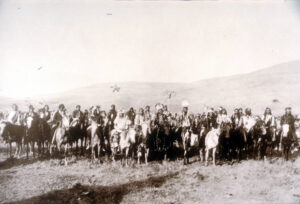 him to surrender the surviving Nez Perce forces to Colonel Nelson A Miles at the Bear Paw battlefield in northern Montana in October 1877. “From where the sun now stands,” he promised, “I will fight no more forever.” Chief Joseph lived out the rest of his life in peace, a popular romantic symbol of the noble “red men” who many Americans admired…now that they no longer posed any real threat, anyway. White settlers had described him as superhuman and a military genius…mainly because he was a diplomat and knew how to reason with people. On September 21, 1904, the Nez Perce leader Chief Joseph died on the Colville reservation in northern Washington at the age of 64.
him to surrender the surviving Nez Perce forces to Colonel Nelson A Miles at the Bear Paw battlefield in northern Montana in October 1877. “From where the sun now stands,” he promised, “I will fight no more forever.” Chief Joseph lived out the rest of his life in peace, a popular romantic symbol of the noble “red men” who many Americans admired…now that they no longer posed any real threat, anyway. White settlers had described him as superhuman and a military genius…mainly because he was a diplomat and knew how to reason with people. On September 21, 1904, the Nez Perce leader Chief Joseph died on the Colville reservation in northern Washington at the age of 64.
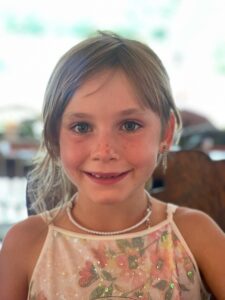
 My grand niece Hattie Parmely is a sweet little princess of a girl, who always wears a smile first. No matter what else she is wearing that day, her smile is her best feature and for a girl who loves her “bling,” it is the best thing she wears…ever. These days Hattie sweet smile is missing a few teeth, but that just makes it all that much cuter. Hattie is very much a girly girl, and she loves her bling. Even wearing blue jeans, Hattie chooses to wear sandals covered with rhinestones, so that her blingy side is displayed too. That was the outfit she had on yesterday at a family dinner. Her outfit was topped off with a pink t-shirt, and she looked very cute.
My grand niece Hattie Parmely is a sweet little princess of a girl, who always wears a smile first. No matter what else she is wearing that day, her smile is her best feature and for a girl who loves her “bling,” it is the best thing she wears…ever. These days Hattie sweet smile is missing a few teeth, but that just makes it all that much cuter. Hattie is very much a girly girl, and she loves her bling. Even wearing blue jeans, Hattie chooses to wear sandals covered with rhinestones, so that her blingy side is displayed too. That was the outfit she had on yesterday at a family dinner. Her outfit was topped off with a pink t-shirt, and she looked very cute.
Hattie and her siblings, Reagan, Bowen, and Maeve, are home schooled, and doing very well in school. I asked Hattie and her older sister, Reagan how they liked their teacher. They didn’t quite get it at first, because I was, of course, asking them how they liked their mom, Ashley Parmely. It was funny, when they caught on. They both looked 
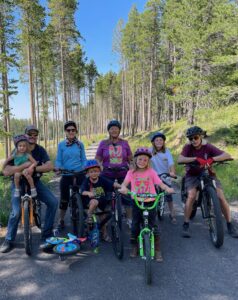 over at their mom and grinned. Hattie also loves to play the piano…something I have always thought I would love to learn, but have never gotten around to doing so. I’m happy that Hattie is going to be able to play the piano, because I think that the ability to play the piano is something that is so fulfilling and so soothing. I think the piano compliments Hattie’s personality perfectly. I love how Hattie has her own sweet personality. Most kids do, but Hattie’s personality is one that strikes me as being a very gentle and loving girl. She chooses to be the blingy girl she is. I am always amazed at how different some of the personalities are in children, even siblings. Of course, with brothers and sisters, that is to be expected, but even with sisters, each one has their own way, and that is what makes us all unique.
over at their mom and grinned. Hattie also loves to play the piano…something I have always thought I would love to learn, but have never gotten around to doing so. I’m happy that Hattie is going to be able to play the piano, because I think that the ability to play the piano is something that is so fulfilling and so soothing. I think the piano compliments Hattie’s personality perfectly. I love how Hattie has her own sweet personality. Most kids do, but Hattie’s personality is one that strikes me as being a very gentle and loving girl. She chooses to be the blingy girl she is. I am always amazed at how different some of the personalities are in children, even siblings. Of course, with brothers and sisters, that is to be expected, but even with sisters, each one has their own way, and that is what makes us all unique.
Living on a farm, Hattie loves to ride horses, and can often be found doing just that. She and her siblings have been raised on the back of a horse, so they are very comfortable there. They have also been raised on a 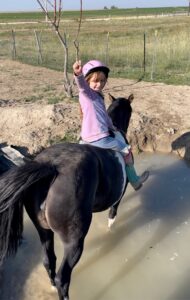
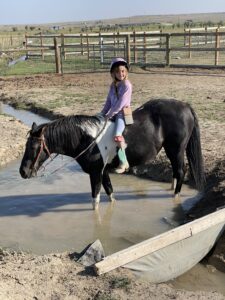 bicycle, so they love to go riding too. The trails on Casper Mountain are favorites among the Parmely and Eighmy families. The fact that Hattie is a girly girl, doesn’t in any way mean that she doesn’t know how or want to take care for all the animals on the family farm, because she loves them all, especially the babies, of which there always seems to be a few. Hattie loves the homeschooled-farm-girl life very much, and if you have ever been out to their farm, you can see why. It is such a relaxed place to be, with no rushing out the door to catch the school bus, or rushing out the door to drive in their parents vehicle to the school…school is just steps away from their bedroom, and that is very nice, indeed. Today is Hattie’s 7th birthday. Happy birthday Hattie!! Have a great day!! We love you very much!!
bicycle, so they love to go riding too. The trails on Casper Mountain are favorites among the Parmely and Eighmy families. The fact that Hattie is a girly girl, doesn’t in any way mean that she doesn’t know how or want to take care for all the animals on the family farm, because she loves them all, especially the babies, of which there always seems to be a few. Hattie loves the homeschooled-farm-girl life very much, and if you have ever been out to their farm, you can see why. It is such a relaxed place to be, with no rushing out the door to catch the school bus, or rushing out the door to drive in their parents vehicle to the school…school is just steps away from their bedroom, and that is very nice, indeed. Today is Hattie’s 7th birthday. Happy birthday Hattie!! Have a great day!! We love you very much!!
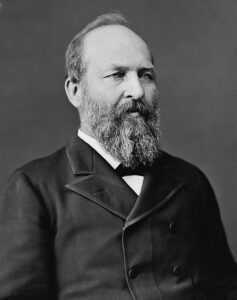 In the history of the United States, 4 presidents have been assassinated. Of course the ones we remember the most are Abraham Lincoln and John F Kennedy. The other two were William McKinley and James Garfield. With Lincoln and Kennedy, death was quick, even though with Lincoln it took until the next day. With McKinley, death came 7 days after he was shot, but with Garfield, death needn’t have come at all.
In the history of the United States, 4 presidents have been assassinated. Of course the ones we remember the most are Abraham Lincoln and John F Kennedy. The other two were William McKinley and James Garfield. With Lincoln and Kennedy, death was quick, even though with Lincoln it took until the next day. With McKinley, death came 7 days after he was shot, but with Garfield, death needn’t have come at all.
President James A Garfield had served as the president for just four months when he was shot on July 2, 1881, by Charles Guiteau in Washington DC. Guiteau had been stalking the president for about a month, and he shot him in the arm and the back. Guiteau wasn’t much of a shot I guess. Garfield didn’t die instantly, and in fact he didn’t die for 11 weeks. In the end, it wasn’t the wounds that caused his death, but rather that the wounds became infected which claimed the president’s life in the end. Had the doctors of that age known more about infection, I believe Garfield might have lived. Infection always comes from exposure to a bacteria or virus. Yes, it could have been introduced by the bullets, but with the proper treatment, the infection could also have been thwarted. Of course, I don’t know if President Garfield would have been able to walk, or move in any other way, because I don’t know how bad the wound in his back was. Nevertheless, a would that took 11 weeks to kill the man, could not have been an infection that could not be healed. Of course, I’m no 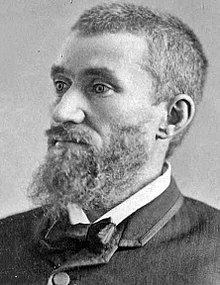 doctor, but then modern medicine has many more tools in it’s belt now than it did then. Ironically, when you think about it Garfield was not the only one of the assassinated presidents who faced exposure and lost. The others were exposed to their assassins bullet, a sad but true fact. It’s just that Garfield suffered a much longer length of time than the others…and that is truly awful.
doctor, but then modern medicine has many more tools in it’s belt now than it did then. Ironically, when you think about it Garfield was not the only one of the assassinated presidents who faced exposure and lost. The others were exposed to their assassins bullet, a sad but true fact. It’s just that Garfield suffered a much longer length of time than the others…and that is truly awful.
Apparently, Guiteau was angry because the president didn’t appoint him to the office he desired. That is an insane reason to kill a man, and Guiteau must have been a man who could not control his own emotions…sadly. While the assassinations of Lincoln, Kennedy, and McKinley are still steeped in conspiracy theories and political ideology, Guiteau’s motivations were simple…egomania, delusions of grandeur, and the belief that God had willed him to “remove” Garfield from office. Guiteau failed to become the “great man” he was striving to be, and after being convicted of murder, Guiteau was sentenced to death and was hanged in 1882.

